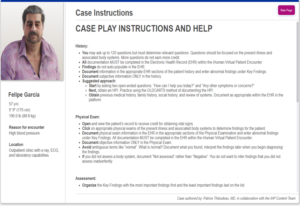COURSE:
NR509: Advanced physical assessment
NR509 Week 5: Assessment of the Abdomen: Felipe Garcia

General Instructions
Access i-Human by clicking the link on the following page. Click the blue bar to launch the activity in a new browser window. The case does not need to be completed in one sitting; it can be re-entered at the same point at a later time.
All graded documentation, including the management plan, must be completed within the i-Human platform. Follow the i-Human Documentation GuideLinks to an external site. to complete your client’s electronic health record (EHR) and management plan. Use current APA Style Standards to format citations and references in the management plan and reflection. Use APA StyleLinks to an external site. and APA Academic WriterLinks to an external site. for formatting and grammar assistance.
Include the following sections (detailed criteria listed below and in the Grading Rubric)
Complete the following components in the i-Human Virtual Patient Encounter.
- Comprehensive Health History
- Complete a comprehensive health history. Scores are automatically calculated within the i-Human platform when the health history is submitted.
- Comprehensive Physical Exam
- Complete a comprehensive physical exam. Scores are automatically calculated within the i-Human platform when the health history is submitted.
- EHR Documentation (Subjective Data): Document the history of present illness (HPI) and focused review of systems (ROS). Documentation must be:
- accurate
- detailed
- written using professional terminology
- pertinent to the chief complaint
- includes subjective findings only
- EHR Documentation (Objective Data): Document physical exam findings. Documentation must be:
- accurate
- detailed
- written using professional terminology
- pertinent to the chief complaint
- include objective findings only
- Key Findings: Organize key findings from the history and physical exam.
- Problem Statement: Document a brief, accurate problem statement using professional language. Include the following components:
- name or initials, age
- chief complaint
- positive and negative subjective findings
- positive and negative objective findings
- Management Plan:Use the expert diagnosis provided to create a pertinent comprehensive evidence-based management plan. If a specific component of the management plan is not warranted (i.e., no referrals are appropriate for the virtual patient) document that no intervention is warranted. Include the following components:
- diagnostic tests
- medications: type a specific prescription for each medication, including over-the-counter medications
- suggested consults/referrals
- client education
- follow-up, including time interval and specific symptomatology to prompt a sooner return
- provide rationales for each intervention and cite at least one relevant scholarly source as defined by program expectations
- Click ”Submit” once the case is complete. Use this guide to download the Performance Overview ReportLinks to an external site..
- Reflection: Download this worksheetLinks to an external site. Address the following question: Some clinicians may find it difficult to explain the logic behind their clinical thinking. As you gain experience, your clinical reasoning will begin at the outset of the patient encounter, not at the end. Reflect on the clinical reasoning you used during this virtual patient encounter. Describe the steps taken to identify and interpret the key findings in this case. What are some “lessons learned” within the assessment that you can apply to your professional practice as a provider? Include the following components:
- type 150-300 words in a Microsoft Word document
- demonstrate clinical judgment appropriate to the virtual patient scenario
- cite at least one relevant scholarly source as defined by program expectations
- communicate with minimal errors in English grammar, spelling, syntax, and punctuation
Solution
